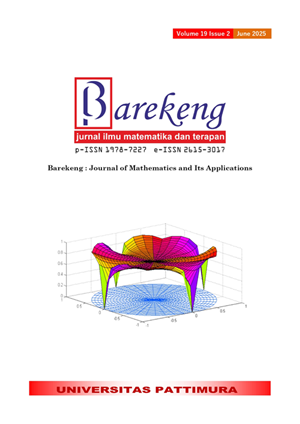ASSESSING UNEMPLOYMENT RATES IN TANAH DATAR REGENCY: INSIGHTS FROM SMALL AREA ESTIMATION
Abstract
Unemployment is a significant issue in Indonesia's labor market. The unemployment rate is measured by the Open Unemployment Rate (OUR) through the National Labor Force Survey (SAKERNAS) conducted by BPS. In 2022, the OUR in Tanah Datar District reached its highest level in the past fifteen years. This rise in unemployment contrasts with the declining poverty rate, unlike other districts/cities in West Sumatra. To address the increasing unemployment, detailed information at the smallest administrative level is necessary. However, because the limited sample size in SAKERNAS does not allow for direct estimation of the OUR with sufficient accuracy, this study aims to overcome this limitation by estimating the OUR at the subdistrict level using indirect estimation through Small Area Estimation (SAE). The SAE method applied is Empirical Best Linear Unbiased Prediction (EBLUP), using the Restricted Maximum Likelihood (REML) estimation model. This research uses secondary data obtained from the National Labor Force Survey (SAKERNAS) of Tanah Datar Regency for the August 2022 period and the Village Potential data (PODES) of Tanah Datar Regency in 2021. The findings indicate that three subdistricts—Pariangan, Lintau Buo Utara, and Padang Ganting—have higher OUR values than Tanah Datar Regency in 2022, with rates of 6.00%, 6.01%, and 11.03%, respectively. The factor that influences the high OUR in these sub-districts is the variable percentage of the male population, which in this model has a large contribution to the calculation of OUR. The indirect estimations using EBLUP are deemed reliable, as the RSE value is below 25%. Therefore, the EBLUP indirect estimation results for OUR at the subdistrict level in Tanah Datar Regency can guide local government efforts to take targeted actions to reduce unemployment, especially in areas with high OUR.
Downloads
References
R. P. Wicaksono, I. K. G. Sukarsa, and I. P. E. N. Kencana, “MEMODELKAN TINGKAT PENGANGGURAN DI KOTA DENPASAR DENGAN PENDUGAAN AREA KECIL EMPIRICAL BAYES,” E-Jurnal Matematika, vol. 10, no. 2, p. 81, May 2021, doi: 10.24843/mtk.2021.v10.i02.p325.
I. Yuni Wulansari, “PENERAPAN EMPIRICAL BEST LINEAR UNBIASED PREDICTION (EBLUP) PADA PENDUGAAN TINGKAT PENGANGGURAN TERBUKA LEVEL KECAMATAN DI PROVINSI BANTEN (EMPIRICAL BEST LINEAR UNBIASED PREDICTION (EBLUP) FOR OPEN UNEMPLOYMENT RATE ESTIMATION AT SUB-DISTRICT LEVEL IN BANTEN PROVINCE),” 2021.
I. K. G. Sukarsa, G. K. Gandhiadi, and I. P. E. N. Kencana, “UNEMPLOYMENT RATE ESTIMATION IN BALI PROVINCE: A SMALL AREA ESTIMATION APPROACH,” BAREKENG: J. Il. Mat. & Ter, vol. 16, no. 1, pp. 157–162, 2022, doi: 10.30598/barekengvol16iss1p157-162.
R. C. Kurniawan, “ANALISIS PENGARUH PDRB, UMK, DAN INFLASI TERHADAP TINGKAT PENGANGGURAN TERBUKA DI KOTA MALANG TAHUN 1980-2011,” 2013.
E. Ikhsan, C. A. Hidayat, and W. A. Nurizza, “EFISIENSI METODE EBLUP PADA SMALL AREA ESTIMATION STUDI KASUS: ESTIMASI PERSENTASE PENDUDUK MISKIN DI PROVINSI NUSA TENGGARA TIMUR TAHUN 2017 (THE EFFICIENCY OF EBLUP IN SMALL AREA ESTIMATION CASE STUDY: ESTIMATION OF POOR POGPULATION PERCENTAGE IN EAST NUSA TENGGARA PROVINCE IN 2017),” 2017.
J. N. K. Rao and I. Molina, SMALL AREA ESTIMATION. John Wiley & Sons, Inc., 2015.
A. Wijaya, Moh. Y. Darsyah, and I. J. Suprayitno, “SMALL AREA ESTIMATION PADA TINGKAT KEMISKINAN DI PROVINSI JAWA TENGAH DENGAN PENDEKATAN EMPIRICAL BEST LINIER UNBIASED PREDICTION,” 2017.
S. Aprizkiyandari and A. Kurnia, “SMALL AREA ESTIMATION IN ESTIMATING UNEMPLOYMENT RATE IN BOGOR DISTRICT OF SAMPLED AND NON-SAMPLED AREAS USING A CALIBRATION MODELING APPROACH,” IJCSN-International Journal of Computer Science and Network, vol. 6, no. 6, 2017, [Online]. Available: www.IJCSN.orgImpactFactor:1.5760
R. Amaliah, “PENDUGAAN AREA KECIL PADA TINGKAT PENGANGGURAN TERBUKA MENGGUNAKAN MODEL FAY-HERRIOT SPASIAL,” 2018.
I. Sintia, M. Danil Pasarella, and D. Andi Nohe, “PERBANDINGAN TINGKAT KONSISTENSI UJI DISTRIBUSI NORMALITAS PADA KASUS TINGKAT PENGANGGURAN DI JAWA,” 2022.
R. Ningtyas, R. Rahmawati, and Y. Wilandari, “PENERAPAN METODE EMPIRICAL BEST LINEAR UNBIASED PREDICTION (EBLUP) PADA MODEL PENDUGA AREA KECIL DALAM PENDUGAAN PENGELUARAN PER KAPITA DI KABUPATEN BREBES,” vol. 4, pp. 977–986, 2015, [Online]. Available: http://ejournal-s1.undip.ac.id/index.php/gaussian
I. Molina, J. N. K. Rao, and G. S. Datta, “SMALL AREA ESTIMATION UNDER A FAY-HERRIOT MODEL WITH PRELIMINARY TESTING FOR THE PRESENCE OF RANDOM AREA EFFECTS,” 2015, [Online]. Available: www.statcan.gc.ca
W. Larasati and N. Permatasari, “PERBANDINGAN METODE SAE EBLUP DAN SAE HB PADA PENDUGAAN AREA KECIL (STUDI KASUS PENDUGAAN KEMISKINAN DI PROVINSI JAWA TIMUR),” Jurnal Statistika dan Aplikasinya, vol. 6, no. 1, 2022.
Kementerian Ketenagakerjaan Republik Indonesia, “KETENAGAKERJAAN DALAM DATA (EDISI 1),” 2024.
E. Ikhsan, N. Yudelsa Ratu, and W. Avie Nurizza, “ESTIMASI SMALL AREA ESTIMATION ANGKA PARTISIPASI KASAR DI PERGURUAN TINGGI PULAU KALIMANTAN TAHUN 2018,” 2019.
B. Hartono and R. Hapsari, “KAJIAN METODE SMALL AREA ESTIMATION UNTUK MENDUGA TINGKAT PENGANGGURAN TERBUKA,” vol. 1, pp. 95–106, 2018.
BPS Tanah Datar, INFORMASI KETENAGAKERJAAN KABUPATEN TANAH DATAR 2022. 2022.
Copyright (c) 2025 Rara Sandhy Winanda, Yasyfin Ikrima Khairani, Fajar Wisga Permana

This work is licensed under a Creative Commons Attribution-ShareAlike 4.0 International License.
Authors who publish with this Journal agree to the following terms:
- Author retain copyright and grant the journal right of first publication with the work simultaneously licensed under a creative commons attribution license that allow others to share the work within an acknowledgement of the work’s authorship and initial publication of this journal.
- Authors are able to enter into separate, additional contractual arrangement for the non-exclusive distribution of the journal’s published version of the work (e.g. acknowledgement of its initial publication in this journal).
- Authors are permitted and encouraged to post their work online (e.g. in institutional repositories or on their websites) prior to and during the submission process, as it can lead to productive exchanges, as well as earlier and greater citation of published works.






1.gif)



